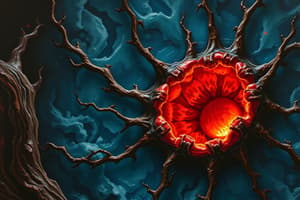Podcast
Questions and Answers
What characterizes caseous necrosis?
What characterizes caseous necrosis?
- A sharp increase in blood pressure
- Presence of inflammatory cells of a granuloma (correct)
- Necrosis of fat cells due to trauma
- Formation of cytoplasmic buds
Which condition is an example of fat necrosis?
Which condition is an example of fat necrosis?
- Tuberculosis
- Rheumatoid arthritis
- Acute hemorrhagic pancreatitis (correct)
- Malignant hypertension
What causes fibrinoid necrosis in small blood vessels?
What causes fibrinoid necrosis in small blood vessels?
- Increased lipase enzyme activity
- Malignant hypertension (correct)
- Inflammation of liver cells
- Cell membrane rupture
Which feature is characteristic of apoptotic cells?
Which feature is characteristic of apoptotic cells?
Which of the following is NOT a physiologic example of apoptosis?
Which of the following is NOT a physiologic example of apoptosis?
What is a common physiologic role for apoptosis?
What is a common physiologic role for apoptosis?
What is one of the early steps in the morphological appearance of apoptosis?
What is one of the early steps in the morphological appearance of apoptosis?
In pathological apoptosis, which of the following represents an apoptotic hepatocyte?
In pathological apoptosis, which of the following represents an apoptotic hepatocyte?
Which factor can lead to fibrinoid necrosis?
Which factor can lead to fibrinoid necrosis?
Apoptosis typically results in which of the following?
Apoptosis typically results in which of the following?
What is characterized by the complete loss of cell and tissue structure due to liquefaction?
What is characterized by the complete loss of cell and tissue structure due to liquefaction?
Which type of necrosis is associated with myocardial infarction?
Which type of necrosis is associated with myocardial infarction?
What is the initial change seen in necrotic cells followed by a series of morphological alterations?
What is the initial change seen in necrotic cells followed by a series of morphological alterations?
Which term describes the characteristic appearance of a necrotic area in gross examination?
Which term describes the characteristic appearance of a necrotic area in gross examination?
What type of necrosis is specifically defined as a combination of coagulative and liquefactive necrosis?
What type of necrosis is specifically defined as a combination of coagulative and liquefactive necrosis?
Which process involves the preservation of cell outlines while losing cellular details?
Which process involves the preservation of cell outlines while losing cellular details?
Which of the following correctly describes the term 'pyknosis'?
Which of the following correctly describes the term 'pyknosis'?
Which of the following types of necrosis is primarily associated with enzymatic digestion by neutrophils and macrophages?
Which of the following types of necrosis is primarily associated with enzymatic digestion by neutrophils and macrophages?
Which type of necrosis is typically noted for its pale yellow color and defined margins?
Which type of necrosis is typically noted for its pale yellow color and defined margins?
Which of these changes does NOT occur in necrotic cells?
Which of these changes does NOT occur in necrotic cells?
Flashcards
Caseous Necrosis
Caseous Necrosis
A type of cell death marked by the breakdown of cellular components and the formation of cheese-like debris. It happens in tissues like the lungs in tuberculosis.
Fat Necrosis
Fat Necrosis
A type of necrosis specific to fat cells. It can be caused by trauma or by the action of lipase enzymes, as seen in acute pancreatitis.
Saponification
Saponification
The process of fat cell breakdown due to the action of lipase enzymes, resulting in the formation of soap-like deposits.
Fibrinoid Necrosis
Fibrinoid Necrosis
Signup and view all the flashcards
Apoptosis
Apoptosis
Signup and view all the flashcards
Embryogenesis
Embryogenesis
Signup and view all the flashcards
Hormone-dependent involution
Hormone-dependent involution
Signup and view all the flashcards
Removal of self-reacting T lymphocytes
Removal of self-reacting T lymphocytes
Signup and view all the flashcards
Councilman Bodies
Councilman Bodies
Signup and view all the flashcards
Neuron loss in Alzheimer's Disease
Neuron loss in Alzheimer's Disease
Signup and view all the flashcards
What is necrosis?
What is necrosis?
Signup and view all the flashcards
What is apoptosis?
What is apoptosis?
Signup and view all the flashcards
What are the gross morphological features of necrosis?
What are the gross morphological features of necrosis?
Signup and view all the flashcards
What are the microscopic changes observed in necrotic cells?
What are the microscopic changes observed in necrotic cells?
Signup and view all the flashcards
Describe coagulative necrosis.
Describe coagulative necrosis.
Signup and view all the flashcards
Describe liquefactive necrosis.
Describe liquefactive necrosis.
Signup and view all the flashcards
Describe caseation necrosis.
Describe caseation necrosis.
Signup and view all the flashcards
Describe fat necrosis.
Describe fat necrosis.
Signup and view all the flashcards
Describe fibrinoid necrosis.
Describe fibrinoid necrosis.
Signup and view all the flashcards
What is the significance or outcome of necrosis?
What is the significance or outcome of necrosis?
Signup and view all the flashcards
Study Notes
Cell Injury - 3
- Intended Learning Objectives: Recall cell death types, describe necrotic cell types, examples, and features, describe apoptotic cell morphology, and compare necrosis and apoptosis.
Types of Cell Death
-
Necrosis: Local death of a group of cells within a living body. It's characterized by the breakdown (rupture) of cell membrane and enzymatic digestion of cellular contents.
-
Apoptosis: Genetically controlled, programmed single cell death. Apoptosis is characterized by cell shrinkage, fragmentation of the nucleus, and formation of apoptotic bodies, which are later phagocytosed. There's no inflammation.
Necrosis
-
Grossly: Necrotic area appears well-defined, swollen, opaque, pale yellow or pale red. Surrounded by a red inflammatory zone.
-
Microscopically:
- Cell membrane disappears. Cells become indistinct from each other.
- Cytoplasm swells and coagulates, appearing homogenous and deeply eosinophilic.
- Nucleus- characterized by pyknosis (shrunken and deeply basophilic), karyorrhexis (fragmented), and karyolysis (disappearance due to chromatin hydrolysis).
Types of Necrosis
-
Coagulation Necrosis: Denaturation and coagulation of structural and enzymatic proteins. Cell outlines and tissue architecture are preserved. Examples: myocardial infarction due to coronary artery occlusion.
-
Liquefactive Necrosis: Complete loss of cell and tissue structure due to liquefaction. Enzymes (autolysis or heterolysis) from cells or white blood cells break down the tissue. Examples: ischemic necrosis of brain (infarction), and pyogenic abscess (infection).
-
Caseous Necrosis: Combination of coagulative and liquefactive necrosis. Tissue is firm grossly, but without cellular details microscopically. Example: Tuberculosis.
-
Fat Necrosis: Necrosis of fat cells, caused by either trauma to fatty tissue or lipase enzyme action. Examples: Traumatic fat necrosis of the breast, Enzymatic fat necrosis of the pancreas and omentum in case of acute pancreatitis.
-
Fibrinoid Necrosis: Death of cells in the inner layer of small blood vessels. It can lead to bleeding and internal damage throughout the body. Causes include malignant hypertension, autoimmune diseases (e.g., rheumatoid arthritis, lupus erythematosus), subacute bacterial endocarditis, and vasculitis (e.g., polyarteritis nodosa).
Apoptosis
-
Morphologic Appearance:
- Cell shrinkage
- Deeply eosinophilic cytoplasm
- Pyknotic (shrunken), then fragmented nucleus
- Intact cell membrane (no rupture)
- Formation of cytoplasmic buds
- Each nuclear fragment goes with a cytoplasmic bud and breaks off to form apoptotic bodies.
- Phagocytosis of apoptotic bodies by adjacent cells or macrophages
- Absence of inflammatory response
-
Physiological Examples:
- Embryogenesis (development of lumens in hollow organs)
- Hormone-dependent involution of tissues in adults (breast size changes after lactation, uterine involution after delivery).
- Removal of self-reacting T lymphocytes in the thymus.
-
Pathological Examples:
- Councilman bodies in viral hepatitis (apoptotic hepatocytes)
- Tumor cell death
- Neuron loss in Alzheimer's disease
- HIV-positive T-lymphocytes die by apoptosis.
Apoptosis vs. Necrosis
| Feature | Necrosis | Apoptosis |
|---|---|---|
| Cell size | Enlarged (swelling) | Reduced (shrinkage) |
| Nucleus | Pyknosis, karyorrhexis, karyolysis | Fragmentation |
| Cellular contents | Enzymatic digestion; may leak out of cell | Intact; may be released in apoptotic bodies |
| Adjacent inflammation | Frequent | No |
| Physiologic/pathologic role | Always pathologic | Often physiologic; may be pathologic |
Studying That Suits You
Use AI to generate personalized quizzes and flashcards to suit your learning preferences.




